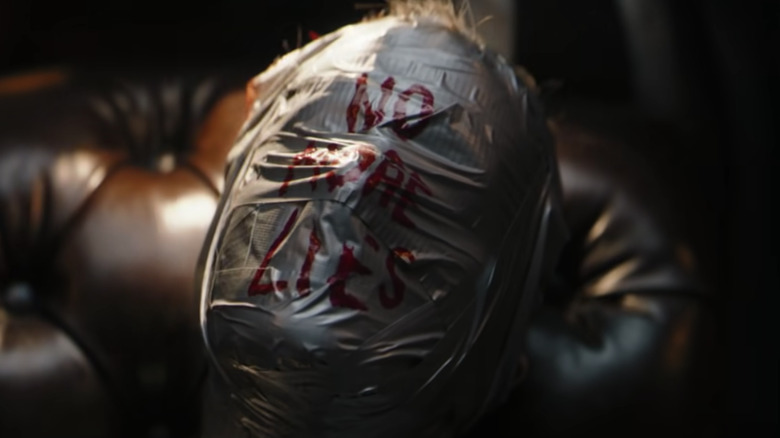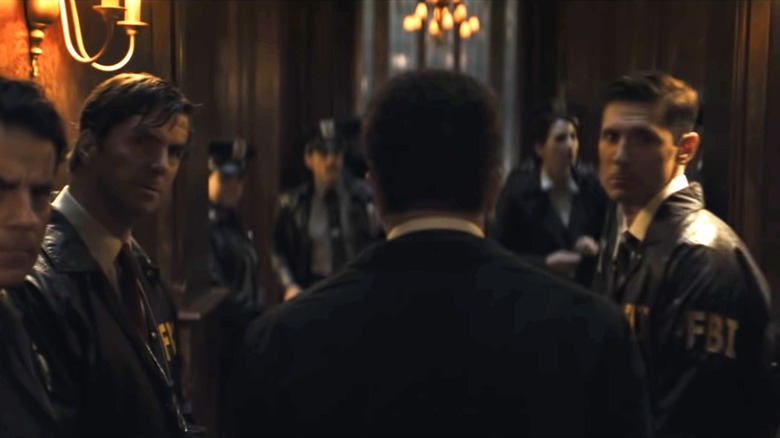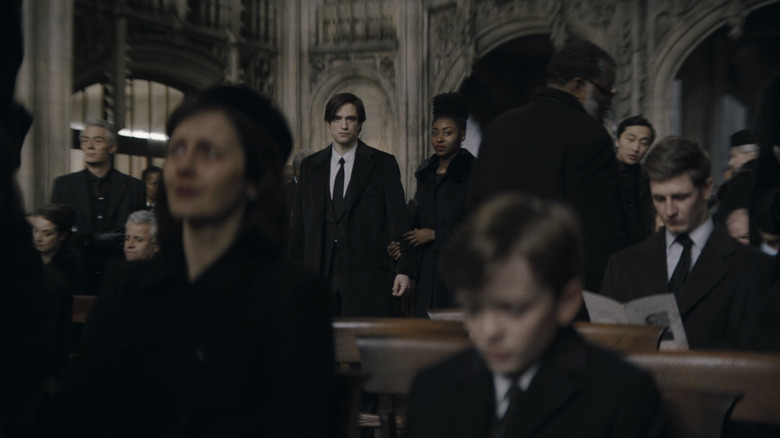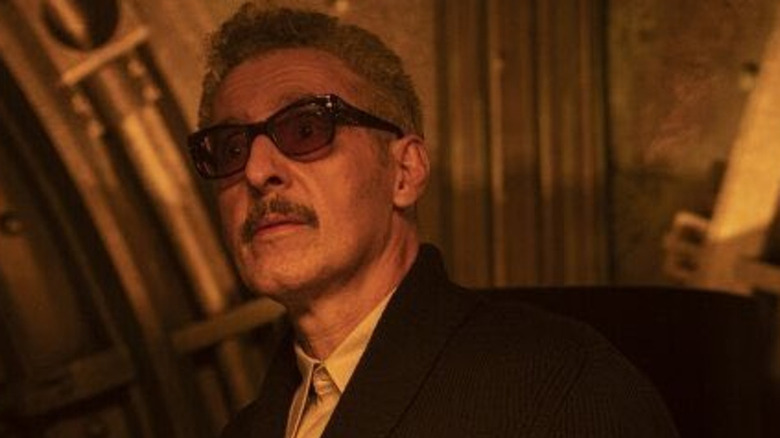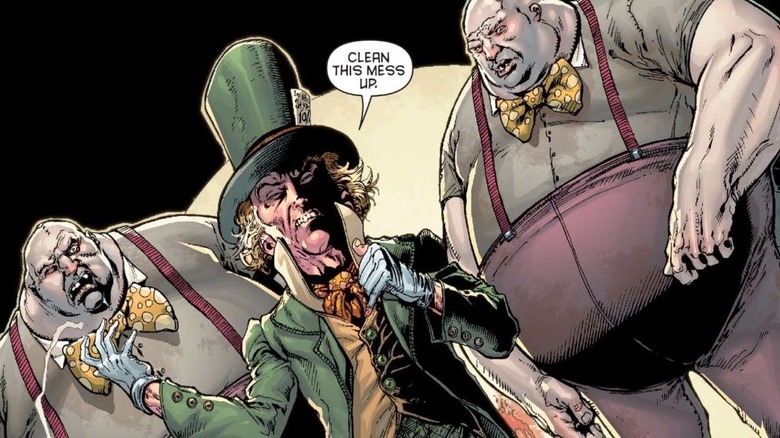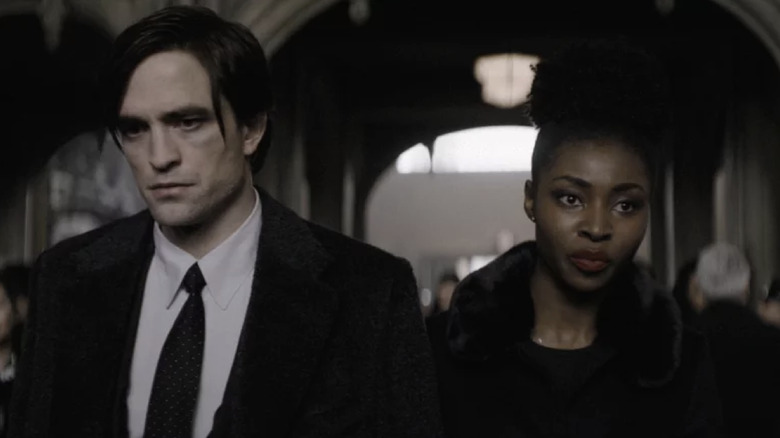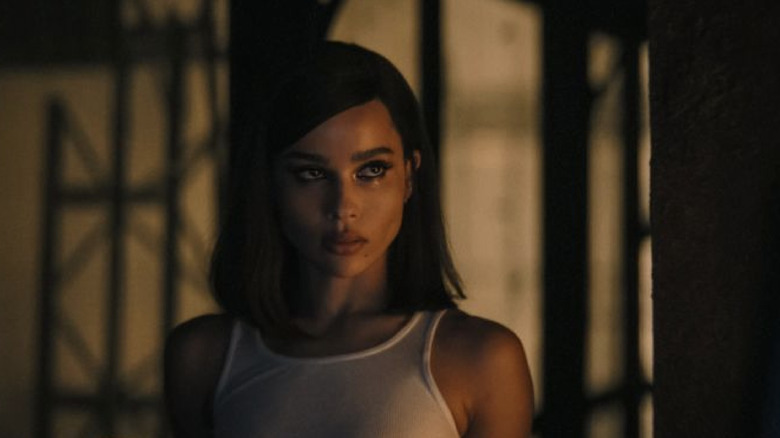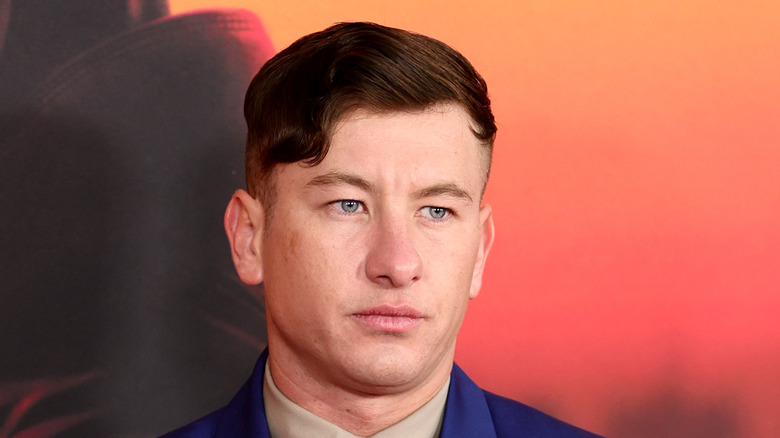Characters In The Batman With More Meaning Than We Realized
In Gotham City, there are shady characters around each corner and a new story seemingly waiting to unfold across the tapestry of every face. With nearly 3000 issues of Batman comics, more than a dozen movies and over a dozen additional live-action and animated series, alongside all the straight-to-video animated films, "LEGO Batman" appearances and who knows what else, you'd think the Batman universe would be tapped out. But with the arrival of Matt Reeves' "The Batman," an entirely new universe of Gotham denizens has come flying at fans like startled bats fleeing a cave.
Some of these characters are immediately identifiable as core components of the story (spoiler alert: The Riddler is important). For others, you might need the skills of the World's Greatest Detective to uncover how they fit into this particular puzzle.
With that in mind, here's a breakdown of the RBattz-adjacent performances you need to watch closely. Whether setting up sequels, expanding the universe, changing the mythology of the franchise or simply stealing a scene for themselves, these are the characters in "The Batman" with more meaning than you might realize.
The cop
It's no secret that Gotham's most famous masked vigilante isn't popular with rank-and-file cops. With the exception of Jim Gordon, in most incarnations of the character (and most certainly in "The Batman"), they would sooner crack his skull open than help him out. This point is driven home early in Reeves' take on Batman, when Gordon and the Bat arrive to examine what's left of Mayor Don Mitchell Jr. (Rupert Penry-Ross) in the wake of an attack by the Riddler.
As Gordon escorts Batman toward the room where it happened, a slew of cops part like the Red Sea, eyeballing the superhero warily. One officer, who Gordon name checks as Martinez, steps up to block Batman from the crime scene. As is made clear, this cop despises Batman and considers it inappropriate for him to be at the scene of the crime. After a tense moment, however, he stands down.
Later in the film, Martinez can be seen professing his admiration of Bruce Wayne — a seemingly throwaway joke. But although the two scenes taken together seem like a simple setup/payoff, there is more at play.
Later in the film, Martinez can be seen again assisting civilians and Batman after Riddler has set off bombs around the outskirts of Gotham, flooding the city. In a very minor, subtle way, this character (who likely has less a minute total screentime in a nearly three-hour film) seems to be undergoing his own character arc, slowly warming up to Batman's mission.
As "Gotham" fans may recall, there was a GCPD officer named Sal Martinez who joined the Strike Force. Assigned to help take down the Penguin, he was killed by Tabitha Galavan.
Why is all this significant? Well, Reeves has announced his intention to create an HBO Max series depicting the inner workings of the Gotham City Police Department. This series will take place in the same universe as "The Batman" and reportedly focus on Batman's first year of fighting crime. "[The series will be] set in the world Reeves is creating for 'The Batman' feature film and will build upon the motion picture's examination of the anatomy of corruption in Gotham City, ultimately launching a new Batman universe across multiple platforms," HBO Max said in a statement to the Hollywood Reporter in 2020. "The series provides an unprecedented opportunity to extend the world established in the movie and further explore the myriad of compelling and complex characters of Gotham."
Perhaps Officer Martinez will never be heard from again. Or, perhaps, this cop could be the key to unlocking an entirely new corner of the DC live-action universe. It's hard to tell, but the way Reeves' camera keeps finding this guy, it sure seems like Martinez is more than your basic beat cop.
The boy
After the mayor is murdered, Batman seems to take a personal interest in his young son — whose first name is never mentioned in the film. The superhero first notices the kid at the crime scene, then again later at the funeral. When the Riddler sends a speeding car containing District Attorney Gil Colson (Peter Sarsgaard) into the church, Bruce Wayne dives on the child, pushing him out of the way at the last moment. As with the aforementioned cop, the boy can also be seen in the film's final act, among the notable Gotham residents Batman helps navigate the flooding waters in the arena.
Sure, this kid could turn out to be nothing. Or perhaps, a few films down the line, he could become some sort of Robin/Nightwing character.
Many of the touchstones appear to be in place: family tragedy, a connection with Batman, a boy in need of help. In the comics, Batman typically begins training a sidekick when they are in their early teens, so there would almost certainly have to be some sort of time jump involved if this kid were going to become Robin in a future movie alongside Pattinson. Also, there are plenty of details that would seem to go against this particular boy's ascension to Robin, from his family name not being any of the known Robins (the character Don Mitchell Jr. was made up for this film), to him not being, say, a circus acrobat.
Nevertheless, this is another character who the camera seems to keep finding, and that often means something substantial is at play.
Could it simply be that this boy reminds Batman of himself when he lost his parents? That he connects with the boy's sadness and feels an obligation to now protect this one child more than almost any other resident of Gotham? Perhaps. Or maybe, just maybe, someday we'll be seeing this kid in a whole new light ... and a cape.
Carmine Falcone
It's hard to watch "The Batman" and not realize that Carmine Falcone (John Turturro) is a major player in Gotham. But at the same time, his presence is so shadowy and his backstory so complex that you might not realize how thoroughly he has influenced this city in decline.
From the first scenes of "The Batman," you can see the newspaper clippings on the wall celebrating the arrest of Salvatore Maroni. Maroni was once Falcone's chief rival, and his arrest opened the city for Falcone's ascension up the ladder of organized crime. As we learn throughout the film, this arrest was engineered by Mitchell on behalf of Falcone.
The crime lord has his fingers in many pies, but also owns the Iceberg Lounge and its "club within the club," the mob hangout 44 Below. This is where Selina Kyle's mother Maria once worked — and Selina has been a regular face there since she was a child, and is now employed there. As Carmine later confesses in a moment of weakness, he killed Maria — and if he'd had his way, he would have killed Selina too.
Then there's the Wayne family. Carmine was once shot in the chest and showed up on the doorstep to Wayne Manor, where Thomas Wayne saved his life. A young Bruce, hiding in the shadows of a stairwell, witnessed the entire incident. It is moments like this that made Bruce grow up thinking his father was a great, noble man whose senseless death needs to be avenged; as Carmine is all too willing to tell an adult Bruce Wayne, however, Thomas got his hands dirty too, leading to the death of a newspaper reporter.
Of course, the Falcone character has been in orbit around Batman for some time, even if he wasn't introduced until the late '80s, long after characters like Joker and the Penguin had been established. Tom Wilkinson played him with menacing aplomb in "Batman Begins," and John Doman fleshed out the mobster stereotype quite a bit on the TV series "Gotham." But Turturro's Falcone is a different beast — one that is not only terrifying, but seems to be the disease that has infected much of Gotham with its ills.
The Twins
The front door at the Iceberg Lounge is manned by two intimidating (if somewhat dim) henchmen serving the Penguin (Colin Farrell) and ultimately Falcone. In an early scene of "The Batman," the Dark Knight shows up at their door and says "Do you know who I am?" and when they don't let him in, he uses his fists to remind them. In a later scene echoing the moment, Bruce Wayne shows up and asks the same question; they allow him in, oblivious to the symmetry.
"The twins," as they are called throughout the film, are played by Max and Charlie Carver from TV's "Teen Wolf." On one hand, they might just be low-level bouncers with the gimmicky bonus of being twin brothers; on the other, perhaps they could indicate Gotham supervillains yet to come.
In the comics, "Tweedledee and Tweedledum" are two gangsters/supervillains whose battles against Batman date all the way back to 1943, much longer than Falcone. One is a good fighter, the other a good thinker. They are actually cousins who just so happen to look alike (and like Lewis Carroll characters), and so Deever Tweed and his cousin Dumfrey lean into their not-so-complimentary nicknames, as well as embracing their similar appearances to confuse enemies.
In some incarnations over the years, Tweedledee and Tweedledum have been criminal masterminds, content to plot out elaborate crimes and let their henchmen handle the execution. In other tales, they themselves are henchmen of someone like the Joker or the Mad Hatter.
So could these "twins" be henchmen for Penguin, who seems to be making his own power play in Gotham's underworld? Could future films have Robert Pattinson's Batman squaring off against Tweedledee and Tweedledum? Such thoughts make us curiouser and curiouser.
Bella Real
Determined to change Gotham through more straightforward means, Bella Real (Jayme Lawson) feels a lot like Aaron Eckhart's Harvey Dent in "The Dark Knight." She's running for office, she's eager for a new day, and she's determined to win. Also like Dent, she's oblivious to the daytime activities of the Batman.
"I wouldn't be bothering you here but your people keep telling me you're unavailable," she says to Bruce Wayne at one point, eager to finally speak with the man. "Your family has a history of philanthropy, but as far as I can tell, you're not doing anything."
Robert Pattinson's Batman doesn't seem too eager to play politics, but that changes when the two come crashing together in the film's final act. As water floods into the arena where they're situated, Real is urged to flee. But she chooses instead to try and help, and is nearly assassinated in the process. This much seems clear: She's won a newfound respect from Bruce Wayne that will likely carry forward into a sequel.
So where does the character go from here? Perhaps as a political ally to Bruce, perhaps as a transformative figure in Gotham. We can only hope that, unlike Dent, she stays on the right side of the law.
Anika Kosolov
Although she's barely glimpsed, the presence of Selina Kyle's friend is felt throughout much of the film. She's the "other woman" in the incriminating photo with the recently murdered Mitchell. It is her visage that sics Batman, like a watchdog, on the scent of the Penguin. When Selina Kyle overhears Anika's name mentioned, she's the one who hurries to tell her friend that the heat is on — in the process revealing herself to Batman as the Catwoman.
But she may be more than just a friend. In an interview shortly before the film's release, Zoë Kravitz claimed that her Selina Kyle is bisexual in "The Batman" and has an intimate relationship with Anika. "That's definitely the way I interpreted that," she told Pedestrian.tv. "They had some kind of romantic relationship."
Reeves, however, seems to respectfully disagree. "I don't think we meant to go directly in that way, but you can interpret it that way for sure," he told the same outlet. "She has an intimacy with that character and it's a tremendous and deep caring for that character, more so than a sexual thing, but there was meant to be quite an intimate relationship between them."
Regardless, the story machinations continue when Batman catches Selina in an attempt to steal back Anika's passport, in a desperate attempt to help her leave the country. But the writing is on the wall, and Anika eventually turns up dead.
So is Anika anything more than a mere plot device? Like many characters in "The Batman," her name doesn't seem to appear in any Batman stories, ever. Almost certainly, she's a new character created by Reeves and co-writer Peter Craig.
As such, Anika means more than you might realize for a few additional reasons. First, she symbolizes Reeves and Craig's preference for creating a credible detective tale rather than a fan-servicing movie filled with Google-able names. Secondly, she represents a fate that seems all too common in Gotham: used, spent, then tossed in a trash can by men of wealth and influence. Anika got caught in the cogs of Gotham's elite, and was mangled in the process.
Or we could be wrong. Maybe she'll come back in the next movie as Poison Ivy.
The Joker?
Supposedly, Barry Keoghan was cast in "The Batman" as officer Stanley Merkel. In the comics, Merkel has a fairly short career as James Gordon's partner before eventually meeting his demise at the hands of The Hangman. As for Keoghan's actual role in the movie, there's some pretty strong indications that the casting news we all heard was a lie — or a joke. Although it's not confirmed in the film itself, it's pretty clear that Keoghan's cackling Arkham neighbor to the Riddler is the Joker. If "The Batman" lands a sequel, there's a strong possibility we'll be seeing more of Keoghan's character ... whatever his name may be.
